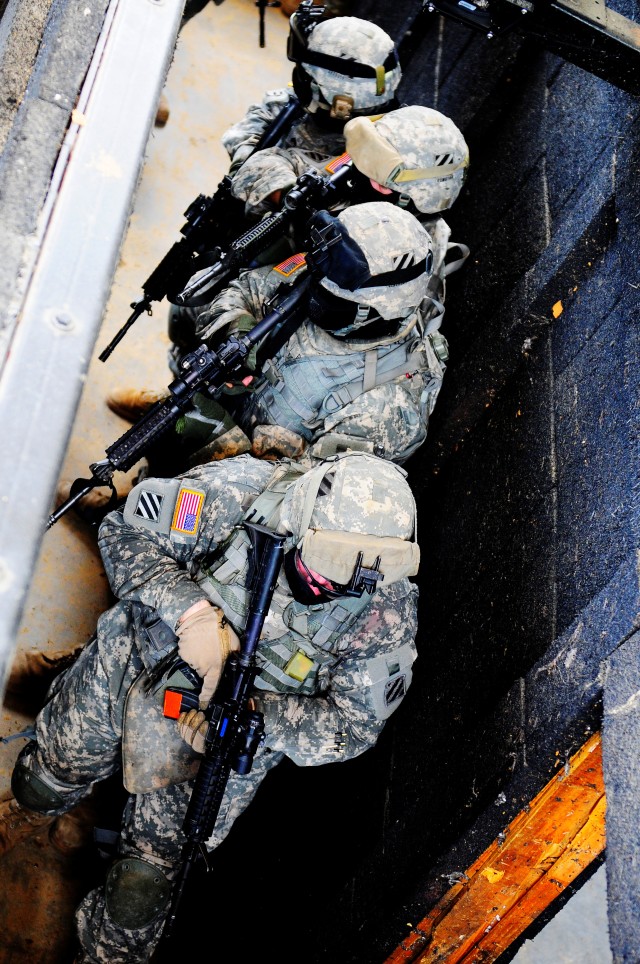FORT STEWART, Ga. </B>- The Soldiers were set, breathing lightly in the summer heat outside the Military Operations in Urban Terrain site. The two squads were stacked up, ready to infiltrate the building and take out any insurgents that appear. Inside, in unknown locations, four mock-insurgents wait, their uniforms stripped of patch and flag, forcing the infiltrating Soldiers to think quickly and pay attention to detail as they clear each room. The team leader motions for the first squad to move in; they kick open the front door and move into the building.
The first is empty, and as the squad prepares to take the intersection, shots ring out as paint blasts the wall next to them, narrowly missing the lead Soldier. The Soldier pokes his rifle around the corner and fires a few rounds, inaccurately, but enough to force the two mock-insurgents into the next room.
Finally, the entire downstairs is clear with one Soldier injured, paint sticking to his glove as the noncommissioned officer in charge calls him out from the catwalk above. After verifying the team's status, the leader stacks them up on a door leading to the staircase, a dark and steep incline that is open on almost every possible side. A bead of sweat drops from the lead Soldier's chin to his rifle as he prepares to enter a room with unknownobstacles and threats.
Although not relieved from their current Consequent Management Response Force mission until October, Soldiers of 5th Squadron, 7th Calvary Regiment are already knee deep in training for deployment. The Crazy Horse Troop of 5/7 Cavalry conducted MOUT training, July 21 on Fort Stewart as part of this change in mission focus, along with 1st Battalion, 41st Field Artillery later that week.
"We are honing individual skills and taking it to the graduate stage by doing collective training in an urban environment then you add the dimension of using live munitions," said Lt. Col. Kirk Dorr, 5/7 Cav. commander. "It really comes together to make an intense training for our Soldiers."
The Soldiers had been out at the shoot house since 6 a.m. the day before.
"Within the last 48 hours out here, we have come a long way," said Capt. Nathan Whitlock. "These guys have gotten several hundred iterations of what we have been doing out here. The Soldiers have improved amazingly; they've increased on tempo and confidence and have been able to do complex scenarios against fire-no fire scenarios with civilians and militant targets. Now they are executing full live-fire scenarios."
But the real force-multiplier in this training was the Close Combat Mission Capabilities Kit, which is essentially a paintball system that uses the M4 and a special bolt so Soldiers can train against other Soldiers. The CCMCK was fielded to Army units on June 26 to give leaders another training method to make their Soldiers and themselves a better fighting force.
"One of the things that make this training so effective is the use of simulation munitions," said Lt. Col. Dorr. "It is a paintball system adapted for the M4, which allows for force on force engagements between Soldiers. Giving the training a realistic, human-to-human conflict angle, which is another step up from your one-dimensional picture target. It's a fantastic system the Army has resourced to take us to the next level."
MOUT training has evolved as the battlefield has changed, especially in the risk a team of Soldiers take when entering a building.
"The Soldiers are doing well," said Sgt. 1st Class Erik Carlson, platoon sergeant in 5/7 Crazy Horse Troop. "We just started practicing in the last week or so, and they are progressing at a good pace. This is a good live-fire, all munitions facility. There are some facilities on Fort Stewart that I would much rather use, but we cannot shoot live ammunition at those sites. On today's battlefield, we have to assume a lot more risks when entering a room. Because of civilian considerations, we can't just prep the room with a frag grenade, and so it is important to be prepared."
The training was effective for both leaders and Soldiers.
"The Soldiers have been progressing very well throughout the training," said Cpl. Brett Quinzon, 5/7 Crazy Horse Troop Scout. "My team could still work on communication a little bit, but we move very well as a team."
The Soldiers rush into the stairwell, firing their weapons with precision, even though their gloves are sweaty and their vision fogged. The mock-insurgents retreat further into the building, using the doorways to take pot shots at the Soldiers as they move tactically forward, watching one another's backs as they press the mock-insurgents into the last room. After a moment of silence, the room explodes with the sound of bolts recharging as paint flies thick in either direction. In the end, the Soldiers still stand, and as they help the mock-insurgents up and help them put their patches back on, there are manywhispered oaths of revenge in the next round, when the tables are turned. Although the training was full of good-natured rivalry, the training was paramount in the Soldiers' transition from peacekeeper to warrior as the 1st Heavy Brigade Combat Team shifts their focus toward deployment operations.
"


Social Sharing